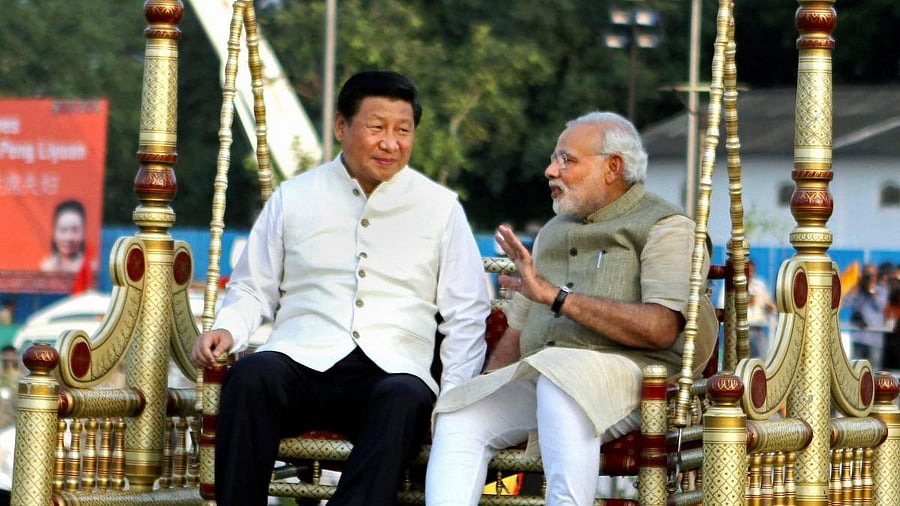
PM Narendra Modi with Chinese President Xi Jinping.
Credit: PTI File Photo
The deeply intertwined nature of India-China economic ties was demonstrated recently by reports that delays in visa clearances had affected progress of major electronics projects. Even as the foreign ministry is viewing Chinese nationals with suspicion, given the tense ties between the two countries, their presence seems to be essential here for the smooth running of many manufacturing units.
The response to this conundrum by an industry association has been to propose that India review trade ties with China, with the aim of gradually reducing the close linkage of the economic ties. The Confederation of Indian Industry (CII) has declared that India’s dependence on electronics components imports poses ‘significant risk’ to the long-term sustainability of the domestic manufacturing ecosystem.
On the issue of heavy import dependence of the electronics industry, the CII has justifiably highlighted the need to transition from an import-dependent assembly-led manufacturing to component-level value-added manufacturing. It has argued that this will be possible only by cutting tariffs on imported components to make domestic output competitive. Equally, it has urged for enhancing incentives under the production linked incentive (PLI) scheme to boost indigenous capacity.
In the short term, however, it seeks a review of the restraints imposed on investments by neighbouring countries stipulated under press note number three. This was aimed as a curb on ballooning Chinese investments here. Evidently, concerned over the impact on the electronics industry, the CII has suggested adequate ‘guardrails’ along with the review.
Yet the India-China economic relationship needs to be viewed from a long-term perspective, rather than viewing it from the prism of the current crisis facing the electronics sector. The latter has been a result of past policies failing to bring about greater indigenisation of components and accessories. The initial wave of setting up mere assembly line units for imported components should have been fast-tracked much earlier into plants with higher value addition.
As far as overall trade and economic ties are concerned, a review of the latest scenario is undoubtedly needed right now. It must be viewed in the context of political tensions that have been simmering ever since the Galwan incident during the pandemic. The continuing hostilities at the border have prompted concerns over the dependence on one country for supplies of critical products like pharmaceutical ingredients and semiconductors.
Such fears have not had any impact on the ground. On the contrary, imports have been steadily going up from $94 billion in 2021-2022 to over $118 billion in 2023-2024. The trade gap has also continued with exports much lower than imports.
Apart from trade, there is considerable investment by Chinese companies here largely in the mobile phones, automobiles, and power sectors. What is more, Chinese venture capital has been involved in many leading unicorns, an issue that has raised much controversy. On the other hand, Indian infrastructure and pharma companies have similarly made investments in China though not to the same extent.
The bottom line is that bilateral economic ties remain closely linked. This is despite efforts made ever since border frictions erupted in 2020 to reduce the level of Chinese investments. This included the radical decision to ban TikTok and many other Chinese apps. Subsequently, railway contracts with Chinese companies were terminated while they were also left out of highway projects and telecom firm Huawei was excluded from 5G trials. The issuance of press note number three specifying that government approvals would be needed for neighbouring countries was expected to be another deterrent to rising investments from the northern neighbour.
No two large economies can indeed carry out complete decoupling in the era of globalisation. Nor is it desirable, even if there are political and security tensions. Many countries continue to have close economic ties despite hostilities. For instance, China and the US continue to have a huge trade relationship despite simmering tensions in recent years. Similarly, European countries are still buying natural gas from Russia despite the conflict in Ukraine.
In India’s case, however, it needs to make efforts to reduce dependence on a high technology area like electronics where supply cuts could affect a wide swathe of industries. Similarly, the shortage of key pharma ingredients could cripple medical facilities in India as was seen during the pandemic. It must be recognised that prolonged frictions at the borders have the potential of disrupting trade flows and this, in turn, could affect industries relying on imports from China.
Given this, it would be wise to ensure that India does not face any severe setbacks in case of supply disruptions. This means the new government needs to take a fresh look at the entire gamut of bilateral economic ties to protect India’s strategic interests.
(Sushma Ramachandran is a senior journalist.)
Disclaimer: The views expressed above are the author's own. They do not necessarily reflect the views of DH.